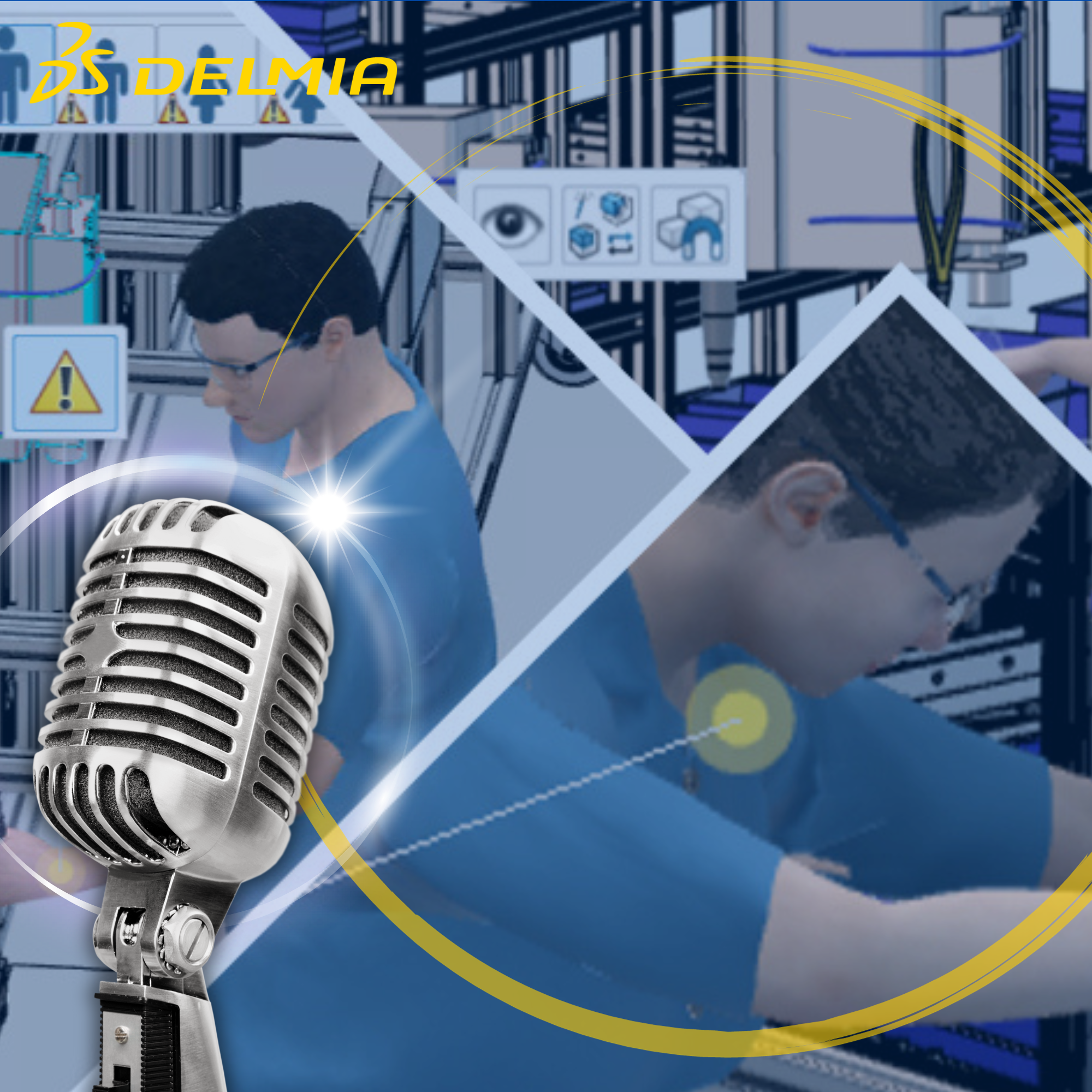Ep: 9 Ergonomic Workplace Designer Made Easy for Non-Experts
Listen to how a DELMIA customer explains how to use Ergonomic Workplace Designer even if you’re a “non-expert.”
Discover a breakthrough role in the design of manufacturing work spaces
In this Podcast, Julie Charland, DELMIA Ergonomics Portfolio Director in Montreal continues the discussion on Ergonomic Workplace Designer, a breakthrough role in the design of manufacturing work spaces. She obtains the customer perspective from Anais Richard, an Ergonomist at a manufacturing company in France revealing how this solution can easily be used by a “non-expert.”
Empowering Manufacturing Engineers to make key decisions in order to design safe and efficient workplaces:
• One-click probable manikin posturing with the Smart Posturing engine technology
• Create better visibility for opportunities to improve safety, productivity and efficiency
• Incorporate ergonomic assessments as part of any project
• Identify and mitigate potential injury risks
• Integrate ergonomics with overall planning with Ergo4all
Learn more and continue the conversation in our DELMIA Ergonomics community.
Meet our speaker
Julie Charland
You can follow the DELMIA "Global Operations on the Go" podcast on Apple podcasts, Spotify, YouTube Podcasts, Deezer, by RSS or wherever you get your podcast


![]()


00:11 Therese Snow
Hi, and welcome to our DELMIA podcast, Global Operations on the Go. I'm your host Therese Snow. Today I'm here with Julie Charland, DELMIA Ergonomics Portfolio Director in Montreal, and Anais Richard, Ergonomist at a manufacturing transportation company in France. We're continuing our discussion on DELMIA’s new solution, Ergonomic Workplace Designer, a breakthrough role in the design of manufacturing workspaces. Julie, for those new to our podcast, can you please tell us a bit about your background?
00:44 Julie Charland
Yes, Therese. My background is in ergonomics and biomechanics. And I have been leading the virtual ergonomic domain at Dassault Systèmes for quite a while now. And I'm happy to be here today.
00:59 Therese Snow
Oh, great. Impressive, Julie. So Anais, could you tell our listeners please a bit about yourself and your background?
01:06 Anais Richard
Yes. So I'm an ergonomist since nine years in industrial companies. I integrate ergonomics in our industrial processes, so, at the beginning of the project. And we try to move to a reactive approach to a proactive approach.
01:23 Therese Snow
Okay, excellent. Well, thank you both for joining us today. This podcast will focus on their perspective from an ergonomist and customer. So, let's start with a bit of context first. So Julie, I hear EWD has been keeping you super busy for the past year. But why did it take that much muscle to bring it to launch?
Industrial engineers designing a workplace so it’s safe and efficient
01:44 Julie Charland
Yes, Therese, Ergonomic Workplace Design, EWD, is aimed at industrial engineers that have to design workplace and make it safe and efficient. What kept us busy is the invention of two technologies behind that product. First one is called Smart Posturing Engine for automatic mannequin positioning in one click, and the other one is called Ergo for All – this is for ergonomic risk, assessment and the suggestion to lower this risk, and it’s aimed at non-ergonomists. These are two scientifically validated technology, patented technology, developed in collaboration with two Montreal engineering schools. So, that has been keeping us super busy.
02:33 Therese Snow
That's great information. So, Anais, being an ergonomist, but hearing Julie say that this tool is actually not aimed at ergonomists. Rather, it's geared toward manufacturing engineers without an ergonomic background. So I wonder, where exactly do you fit in this picture?
02:54 Anais Richard
Yeah, for me to develop the prevention approach in ergonomic, we need to integrate it into all departments at the beginning of the project. So, as engineering, industrialization, to the designer, etc. And for me, thanks to ergonomic workstation design, we can provide an objective analysis thanks to an automatic positioning of the mannequin, and we have an ergo evaluation, very visual and visible by whole. So, as Julie said, it’s not necessary to be an expert. And as we can see the tools we have the recommendation associated with the ergo rating to modify the design in life. So, it's very good to have time saving in the analysis of our process. So, it's a speed simulation of the working activities, same to an automatic positioning of the mannequin.
03:49 Therese Snow
Okay, so yeah, it's interesting, you said that you don't have to be an expert. I certainly think that's going to appeal to a lot of people out there and leads me to my next point, Julie, what happens when an EWD user doesn't have access to an ergonomist in house for example?
Lower the risks assessed by Ergo for All
04:07 Julie Charland
Yeah, not all manufacturing company that has the locker or the ability or the structure to have ergonomists in house, just like Anais is part of a structure and is part of the manufacturing company where she worked with directly with these people. It's not always the case. So when it's not the case, when the manufacturing engineers are kind of by themselves and there's no ergonomist in house, we thought about putting them in contact with an ergonomist such as Anais that knows the game of working in 3D. So, this means right there in the app, while making design changes to try to lower the risks assessed by Ergo for All, the user, the manufacturing engineer with no ergonomic background, can click on a button and be put in contact directly with an ergonomist.
So, Therese, this happens sometimes when either the task or the environment is too complex or you know once in a while, Anais, maybe if you feel this, but once in a while you change something in the design, it makes it good in one area, and then, but it makes it bad in another area and then you change the design again and now you have another problem in another place. Sometimes it's very, very hard to cope with that. So, this button contacts an ergonomist, will help the design, the designer to make a workplace safe. We hope this will bridge the two worlds together.
05:35 Therese Snow
Good explanation, Julie. So Anais, do you feel that the ergonomic field might be a bit reluctant for manufacturing engineers without an ergonomic background to actually evaluate workplace safety?
Ergonomic assessment tools
05:49 Anais Richard
Today, ergonomic assessment tools permit to increase the skills of stakeholders, industrial stakeholders. So, it promotes a multidisciplinary approach and also to develop the autonomy in terms of prevention. So thanks to this, we can detect and assess ergonomic risk factor as a major element of our ergonomic approach before manufacturing, and thanks to this, we can also integrate ergonomic in the design of the part, of the jigs and tools, and our layout, and our equipment and machines, and all the things in our processes.
06:39 Julie Charland
So Anais, can you comment on how things would work if someone in the frontline, like a manufacturing engineer, finds problems? How do you want to know about it and how often? Or where would you like to fit in there or to be flagged, in the ideal world, what would you see?
07:02 Anais Richard
Today we, for the moment, we have not enough efficiency to detect ergonomic risks during the design phase of the project. And for that, I think it's very important to establish an ergonomic culture within the companies. All new employees must be made aware through trainings, for example. And the message I would like to highlight is all the companies’ employees have a role to play, from risk identification to the deployment in the implementation of a prevention action plan. And thanks to these type of analysis tools, we can be more autonomous and respect the different ergonomic recommendation.
07:43 Therese Snow
Absolutely. Thank you and Anais, and so Julie, now that EWD is out there, what are your expectations?
Democratize ergonomics to bridge the world of 3D and the world of ergonomics and safety
07:51 Julie Charland
Well, I would say it's rather hope than expectation. I'm hoping, and I think all the Montreal team that has put their heart and soul and mind and brains into this product, to democratize ergonomics to bridge the world of 3D and the world of ergonomics and safety. I like the word that Anais used, saying all companies’ employees have a role to play in prevention. So, I hope with this democratization, with this bridge, we will be able to empower the first line, the manufacturing engineers, to play that role of prevention. So, that's my hope, Therese, now that this product is out.
08:39 Therese Snow
Hope, absolutely. Now that's a good word, Julie, and I'm sure that with EWD being out there, and as you had described, I'm sure it'll come to fruition. So, thank you, Julie, and thank you and Anais for this really interesting conversation on DELMIA’s Ergonomic Workplace Designer.
08:57 Julie Charland
Thank you, Therese. It was good to be here and good to be here with Anais, thank you so much.
09:03 Anais Richard
Thank you, too. Thank you for your invitation.
09:06 Therese Snow
Absolutely. My pleasure. Thank you both. I'm your host Therese Snow and thank you for listening to Global Operations on the Go.


